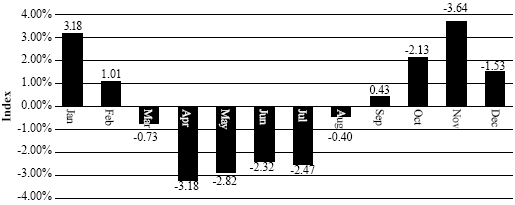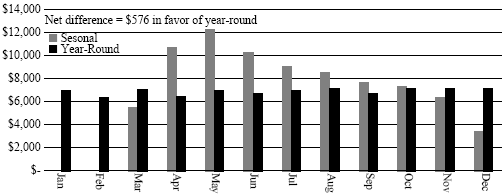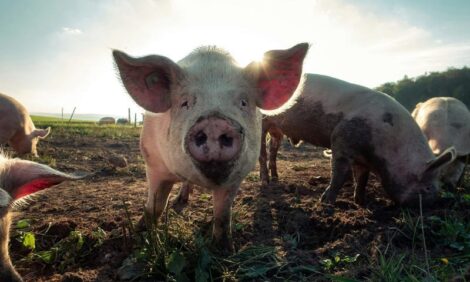



The Income Side of Seasonal vs. Year-Round Pasture-based Milk Production
By Gordon Groover; Extension Agricultural Economist, Virginia Tech.
Introduction
One issue in the debate on dairy production is seasonal versus year-round milk production. The frame of reference in this debate is seasonal price trends. Farmers historically receive the lowest milk price for milk sold during the six months following spring pasture flush. Conversely, the season's highest price is received during the period of October to January. The driving force behind the current interest in grass-based dairy production is lowering total costs per hundredweight of milk sold by using pasture as the primary source of forage. However, producers are discouraged from switching to seasonal production based on the premise that the lower seasonal prices during spring and summer will cancel out any cost savings from pasture.The purpose of this analysis is to discuss the issues related to seasonal price patterns affecting gross milk sales for individual dairy producers. The choice between seasonal or year-round production for pasture-based dairy farms must be based on profitability of the farm business. Milk prices and farm-level costs exhibit seasonal price patterns and affect the profitability of dairy farms. Detailed data for determining farm-level costs and their seasonal patterns for pasture-based dairy farms are limited and few exist for Virginia farms. A description of Virginia's seasonal milk price patterns can shed light on the income side of the farm profitability equation.
Seasonal Milk Production
What is seasonal production? Based on profitability of New Zealand systems that match peak milk production to peak pasture, US dairy producers are seeking to increase profits by maximizing use of pastures and reducing the reliance on stored forages. Seasonal production is based on a 12-month pattern where all cows are bred to calve in an approximate 60-day window and then the whole herd is dried off at the same time. Milk production ceases for a specific period (30-60 days) before cows calve the following year.New or current dairy producers seeking to develop a seasonal herd face many challenges. One of the major challenges is reproductive management of the lactating herd to maximize the number of cows freshening in this short calving window. Cows not calving in this window must leave the herd, if the seasonal herd cycle is to be maintained. Thus, cows not meeting this calving pattern will need to be sold or leased to other dairy producers as replacements or sold as culls which represents a cost to the operation. Seasonal producers must develop strategies to maintain cow numbers in this window, by improving breeding efficiency, buying cows, using bulls, or breeding additional cows and heifers to maintain an efficient herd size. Year-round producers have less critical time constraints for reproductive management of the herd and can attempt more than two breedings before cows are culled.
Seasonal milk prices: Historically, agricultural prices have shown a seasonal price pattern that corresponds to changes in production/harvest (supply) and end-use (demand). The magnitude of price movements above and below the Virginia average milk prices for June 1987 to July of 1997 is shown in Figure 1. The seasonal price index was calculated using a centered 12-month moving average method1 (Purcell, 1979). November is the month with the highest seasonal price, 3.64 percent above the average, and April is the lowest with 3.18 percent below smooth pattern with implications that Christmas and New Year's school holidays reduce the demand for milk. The overall magnitudes of the price swings are fairly small with only a 6.8 percent movement from the highest to lowest months. Seasonal dairy producers freshening the entire herd in February and March and reaching peak production in April and May will routinely sell the majority of their milk at the lowest seasonal prices. In addition, seasonal herds will produce the least amount of milk and dry-off their cows during the time of highest seasonal prices (October-February). Thus, seasonal producers face the prospect of reduced total income based on historical price patterns.
Implications of seasonal vs. year-round production: The index for 1987-97 was used to calculate the total income for a seasonal herd operation with monthly milk sales for 1996 and 1997. The example herd2 has approximately 57 cows in the lactating herd receiving a majority of their forage requirements from pasture. Total milk sales from the two years were averaged to give monthly production. No milk was sold during January or February with the first lactations beginning in March. Total pounds of milk sold (576995.5 lbs) during the 10 months of lactation were equated to selling 48083 pounds per month, based on average monthly production for Virginia DHIA herds during 1996 and 1997, to provide similar output for a grazing herd producing the same amount of milk on year-round schedule. A season average price of $14.00 per hundredweight was used along with the seasonal price index to calculate the net difference in total annual milk sales between seasonal and year-round production. The results of the comparison between seasonal and year-round milk sales show a net difference of $756 or approximately 1 percent of gross milk sales (Figure 2). Thus, farms with the same level of production will experience very little difference in gross milk sales by choosing seasonal over year-round production.
Figure 1: Seasonal Price Index for Grade A Milk 1987-97 (Source: Va. Ag Statistics)

Figure 2: Seasonal vs. Year-Round Milk Sales 87-97 ($14.00)

Other issues related to seasonal production
The overall difference in gross income between selling milk seasonally versus year-round is very little. Utilization of pastures in place of stored forages can quickly compensate for the 1 to 2 percent reduction in gross income from seasonal sales. Thus, rejecting seasonal production based on selling the majority of the milk during the lowest price period of the year is of little consequence. However, dairy producers must consider a number of other issues before becoming seasonal.Regional differences: Using statewide prices can mask the true variability that individual producers may experience in their monthly milk check. Within Virginia, large swings between seasonal prices received by individual farmers can occur. Cooperatives sell milk into varying markets on the East Coast and these differences will be reflected in seasonal prices farmers see in their checks. Dairy producers need to compare the seasonal price patterns of their cooperative to the statewide price patterns for possible differences. Differences in price patterns will affect the results of this analysis.
Milk base: In Virginia, many farmers own Virginia Milk Commission Base (VMCB), which is an intangible asset that is owned by the farm business. VMCB gives the farm the right to sell quantities of milk at Class I prices equal to their VMCB. The pounds of VMCB owned by a farm must be met for the farm to retain this price advantage. Farmers who do not ship milk during a specific period (30 days) face the possibility of loosing their base. VMCB can be bought and sold within Virginia3; therefore, it has value to the owner. Clearly, farmers who own VMCB should not produce seasonally and put their asset in jeopardy. One option would be to sell their base and use the proceeds in the farm operation. This decision should only be considered after close financial analysis about the long-term and tax implications to the financial stability of the farm business.
Virginia is served by a number of dairy cooperatives that have a variety of base plans and incentive programs to maintain a steady supply of milk to their plants. These base and incentive programs offer farmers a higher average price for their milk or pay more for milk production in low supply periods (fall and winter). Producers who own base in a cooperative or can take advantage of incentive plans to ship milk in low supply periods must also consider all financial implications before the decision to go seasonal is finalized.
The human side: Dairy producers who produce milk seasonally like having the cows dry for a specific period because they get a break from the daily requirements of milking and the activities required to keep a constant flow of milk through the bulk tank. "We can take a vacation," they say. In addition, they also like the predictability of the work routine, "We freshen our cows and raise a group of calves for 2 months, breed cows and heifers for 2 months, and then we do not have to do those chores for another 12 months."
Cash flow: The drawback to stopping milk production is the drastic reduction in cash flow the farm family will experience during the dry period. Farm businesses with monthly debt service requirements or farm businesses that provide the majority of family income must plan very carefully their cash flow needs. Development of sound budgeting procedures for the farm and family are a must to provide adequate cash flow and debt servicing capacity for the months without income.
Management: Seasonal dairying compresses most of the management and work activities into short periods that allow little room for mistakes. To keep the seasonal dairy production system on a 12-month cycle, managers must plan intensely and gear-up for each of the seasonal activities. As with breeding, cows and heifers must be bred to calve in a 60-day or shorter window to maintain herd size and reduce the number of replacements that must be purchased. At the same time, pressure is experienced trying to successfully raise the large group of calves that will be needed for replacements or to provide additional income from heifer sales. Failure of management to successfully carry out any of these tasks during the compressed time frame can have drastic consequences on the profitability of the farm business. Year-round farms can have a month of unsuccessful breeding that may impact only one-twelfth of the herd and suffer limited adverse consequences. Consequently, a month of unsuccessful breeding for a seasonal herd could impact more than half of the herd.
Managers need to be acutely aware of peak demands on farm resources and labor. Year-round production allows for constant use of inputs and facilities over the year. However, seasonal production will require that bulk tanks, calf rearing facilities, breeding programs, etc., can accommodate the peak demands of seasonal production. In addition, year-round farms have a fairly steady demand for labor throughout the year. However, seasonal farms will have peak demands during the first 6 months of production and then drop-off substantially during the planned dry period. Hiring and keeping high quality employees is an expensive yet necessary requirement for all dairy farm businesses. Seasonal dairy producers will have to carry the extra costs of paying for quality labor during the dry-period when activities are limited.
Costs: The purpose of this analysis was to discuss the issues related to seasonal price patterns that will affect gross sales as a starting point for a detailed profitability analysis required to assist in selecting a dairy production system. Missing from this discussion are the differences in costs associated with year-round grass-based (pasture in spring and summer, feeding stored forages in fall and winter), seasonal grass-based, or conventional dairy production. The decision to produce milk seasonally must be based on the farm's projected profitability and the ability to generate cash flow before any dairy system is selected. A few studies and farm-level analyses comparing overall profitably of pasture-based dairy systems have been conducted; however, implications to Virginia are limited. Additional studies are required to address the costs associated with pasture-based dairy production.
Conclusion
Seasonal milk production is being adopted by a limited number of Virginia's pasture-based dairy producers for numerous reasons. Farmers should make the decision to become seasonal based on sound financial analysis, personal choice about the human side or time management, or a combination of these issues. Since selling most of the milk produced during the lowest price period has little impact on total gross sales, basing the decision to become seasonal or not solely on this criterion may be a mistake.Notes:
1 Contact the author (e-mail:[email protected] or phone: 540-231-5850) for a spreadsheet application for calculating seasonal price indices. )
2 This herd was selected only to provide a realistic pattern of milk production for a seasonal grazing herd.
3 VMCB at public auctions within the last year has sold in the range of $0.50-0.55 per pound (Ownby Auction and Reality).
References:
Purcell, W. D. Agricultural Marketing: Systems, Coordination, Cash and Futures Prices. Reston Publishing Company, Inc. Reston, Va. 1979.
Virginia Agricultural Statistics Service (VASS). Virginia Agricultural Statistics Annual Bulletin, Various issues. Richmond, Va. 1979-1997.
February 2000



